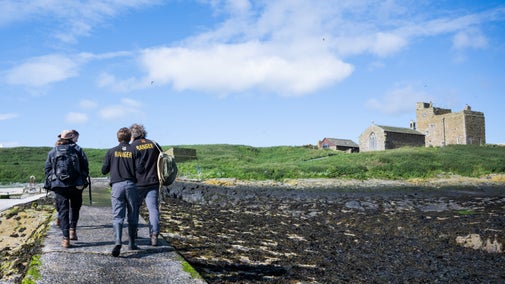
Seal facts and spotting guidance
Learn all about seals, from how long they live and what they eat, to how long seal pups take to grow and the threats to their survival, plus see our seal-spotting guidance.

The Farne Islands are home to thousands of grey seals – also known as Atlantic grey seals – and each autumn around 3000 pups are born here, and the first of these are now appearing on the islands. Learn all about the grey seal colony on the Farnes.
The Farne Islands are home to one of the largest grey seal colonies on the east coast of England. Around 2.5 per cent of the pups born annually in Britain are from the Farnes. By comparison, 20 per cent are born on the Monach Islands in the Outer Hebrides, which is the largest British colony. Grey seals are also known as Atlantic grey seals (Halichoerus grypus atlantica).
Very small numbers of common seals (also known as harbour seals) live on Holy Island. There are also small numbers around Teesside and larger colonies around the Wash. Common seals are very rare on the Farnes – an average of just one is recorded per year.

From the 12th century onwards, the seals on the Farne Islands were harvested by the monks who lived here. They were valued because of the oil that could be extracted from their carcasses and were also prized as a luxury food. As creatures of the sea, seals counted as fish and could be eaten on a Friday.
In 1378–79 a seal calf could fetch about 22p which works out at about £140 in today’s money. We know from documents that there was quite a trade in seals and seal products from the Farnes until the 1500s.
The seals may seem common here, but they are not so common globally. Around 40 per cent of the world’s grey seals breed in the UK so this country is extremely important for this species.
Storms, particularly those coming from the north, can be devastating for seals as they strip pups from some of the low-lying islands and cause mass deaths. Seals on some of the higher islands such as Staple and Brownsman are less prone to wave-wash.

Learn all about seals, from how long they live and what they eat, to how long seal pups take to grow and the threats to their survival, plus see our seal-spotting guidance.
Every year, thousands of puffins come to the places in our care to breed. Discover more about what they eat, when they breed and the best time to see them.

Find out more about how we care for Farne Islands in Northumberland, from repairing the boardwalks to surveying seals and ringing birds to track their movements.
